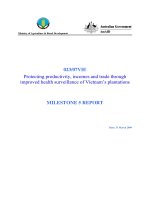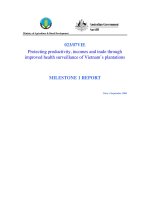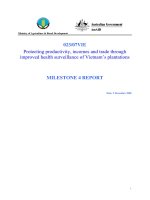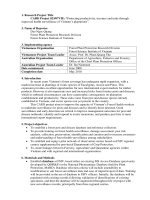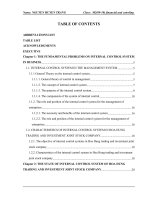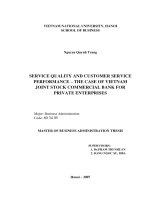INTERNAL CONTROL FOR GEOGRAPHICAL INDICATIONS INTERNATIONAL EXPERIENCE AND APPLICATION FOR THANH HA LYCHEE OF VIETNAM
Bạn đang xem bản rút gọn của tài liệu. Xem và tải ngay bản đầy đủ của tài liệu tại đây (1.77 MB, 137 trang )
MINISTRY OF EDUCATION AND TRAINING
FOREIGN TRADE UNIVERSITY
DISSERTATION
INTERNAL CONTROL FOR GEOGRAPHICAL INDICATIONS:
INTERNATIONAL EXPERIENCE AND APPLICATION FOR
THANH HA LYCHEE OF VIETNAM
Master of International Trade Policy and Law
Tran Thi Thanh Tam
Ha Noi - 2016
ii
MINISTRY OF EDUCATION AND TRAINING
FOREIGN TRADE UNIVERSITY
DISSERTATION
Internal control for Geographical Indications: international experience
and application for Thanh Ha lychee of Vietnam
Master of International Trade Policy and Law
Full Name:
Tran Thi Thanh Tam
Supervisor: Assoc. Prof. Dr. Le Thi Thu Ha
Hanoi - 2016
i
STATEMENT OF ORIGINAL AUTHORSHIP
The work contained in this thesis has not been previously submitted to meet
requirements of an award at this or any other higher education institution. To the best of
my knowledge and belief, the thesis contains no material previously published or written
by another person except where due reference is made.
ii
ACKNOWLEGEMENT
This research would not have been possible without the kind support of many
people. I would like to sincerely thank my supervisor, Assoc. Prof. Dr. Le Thi Thu Ha,
who read my numerous revisions and helped shed light on the confusions. Also I highly
appreciate the support provided by the leaders and members of Thanh Ha Lychee
Production and Commercialization Association, the colleagues at Hai Duong Department
of Science and Technology, Thanh Ha People’s Committee, specifically Economic and
Infrastructure Division and Agriculture and Rural Development Division, as well as local
and foreign experts. I would also like to express my gratitude to my classmates at the
programme Master of International Trade Policy and Law, who shared this long process
with me, always offering help.
iii
TABLE OF CONTENT
INTRODUCTION .............................................................................................................. 1
CHAPTER 1: THEORETICAL OVERVIEW ................................................................ 7
1.1.
Overview of GI ..................................................................................................... 7
1.1.1.
Definition of GI ............................................................................................. 7
1.1.2.
Role of GI protection ................................................................................... 11
1.1.2.1.
1.1.2.2.
1.1.2.3.
1.1.3.
1.2.
From perspective of consumers ................................................................................................................... 11
From perspective of producers.................................................................................................................... 12
From perspective of Governmental Authorities .......................................................................................... 12
Right to use GI ............................................................................................. 13
GI control ........................................................................................................... 14
1.2.1.
Layers of GI control .................................................................................... 14
1.2.2.
Importance of GI control ............................................................................ 16
1.2.2.1.
1.2.2.2.
1.2.2.3.
1.3.
From the perspective of consumers ............................................................................................................. 16
From the perspective of producers .............................................................................................................. 17
From the perspective of Governmental Authorities ..................................................................................... 18
GI internal control ............................................................................................. 18
1.3.1.
Definition of GI internal control ................................................................ 18
1.3.2.
Activities of GI internal control .................................................................. 20
CHAPTER II: INTERNATIONAL EXPERIENCE IN GEOGRAPHICAL
INDICATION INTERNAL CONTROL ........................................................................ 22
2.1.
Experience in Europe: GI internal control in France .................................... 23
2.1.1.
2.1.1.1.
2.1.1.2.
2.1.1.3.
2.1.2.
2.1.2.1.
2.1.2.2.
2.1.2.3.
2.1.2.4.
2.1.3.
2.1.3.1.
2.1.3.2.
Overview on GI in France........................................................................... 23
GI registration in France ............................................................................................................................ 23
GI management in France........................................................................................................................... 30
GI protection in France............................................................................................................................... 33
GI internal control in France ..................................................................... 34
Organisation in charge of internal control: GI association ........................................................................ 34
Tools for internal control ............................................................................................................................ 37
Internal control process .............................................................................................................................. 39
Summary and remarks ................................................................................................................................. 41
Case study: Oignon doux des Cévennes ..................................................... 42
Introduction about Oignon doux des Cévennes ........................................................................................... 42
Organisation in charge of internal control: GI association of the Oignon doux des Cévennes .................. 43
iv
2.1.3.3.
2.1.3.4.
2.2.
Tools for internal control of the Oignon doux des Cévennes ...................................................................... 47
Internal control process of the Oignon doux des Cévennes......................................................................... 49
Experience in Asia: GI internal control in Thailand ..................................... 50
2.2.1.
2.2.1.1.
2.2.1.2.
2.2.1.3.
2.2.2.
2.2.2.1.
2.2.2.2.
2.2.2.3.
2.2.2.4.
2.1.3.
2.1.3.1.
2.1.3.2.
2.1.3.3.
2.1.3.4.
Overview on GI in Thailand ....................................................................... 50
GI registration in Thailand ......................................................................................................................... 51
GI management in Thailand ........................................................................................................................ 56
GI protection in Thailand ............................................................................................................................ 57
GI internal control in Thailand .................................................................. 59
Organisation in charge of internal control: GI operators groups............................................................... 59
Tools for internal control ............................................................................................................................ 61
Internal control process .............................................................................................................................. 62
Summary and remarks ................................................................................................................................. 64
Case study: Sakon Nakhon Mak Mao Berry and Juice ............................ 64
Introduction about Sakon Nakhon Mak Mao Berry and Juice .................................................................... 64
Organisation in charge of internal control: Sakorn Nakorn Mak Mao Club .............................................. 66
Tools for internal control of the Sakon Nakhon Mak Mao Berry and Juice ................................................ 67
Internal control process of the Sakon Nakhon Mak Mao Berry and Juice .................................................. 67
CHAPTER III – GEOGRAPHICAL INDICATION INTERNAL CONTROL FOR
THANH HA LYCHEE OF VIETNAM .......................................................................... 69
3.1.
GI in Vietnam and Thanh Ha lychee as a GI .................................................. 69
3.1.1.
3.1.1.1.
3.1.1.2.
3.1.1.3.
3.1.2.
3.1.2.1.
3.1.2.2.
3.2.
GI in Vietnam .............................................................................................. 69
GI registration in Vietnam .......................................................................................................................... 69
GI management in Vietnam ......................................................................................................................... 75
GI protection in Vietnam ............................................................................................................................. 77
Thanh Ha lychee as a GI ............................................................................ 78
About Thanh Ha and Thanh Ha lychee ....................................................................................................... 78
Thanh Ha lychee registered as GI ............................................................................................................... 80
Current status of internal control for Thanh Ha lychee of Vietnam ............ 81
3.2.1. Organisation in charge of internal control: Association of Production and
Trade of Thanh Ha lychee ......................................................................................... 81
3.2.1.1.
3.2.1.2.
3.2.1.3.
3.2.1.4.
3.2.1.5.
3.2.2.
3.2.2.1.
3.2.2.2.
3.2.3.
3.2.3.1.
3.2.3.2.
Establishment of the Association ................................................................................................................. 81
Membership mechanism of the Association ................................................................................................. 83
Organisational structure of the Association ................................................................................................ 85
Functions of the Association ....................................................................................................................... 88
Budget maintenance of GI association ........................................................................................................ 88
Tools for internal control ............................................................................ 89
GI specification ........................................................................................................................................... 90
Internal control plan ................................................................................................................................... 90
Internal control process .............................................................................. 91
Continuously monitoring the production practices ..................................................................................... 91
Organising annual internal audit ................................................................................................................ 92
v
3.2.3.3.
3.2.3.4.
3.2.4.
3.3.
Managing the use of the branding recognition tools ................................................................................... 92
Facilitating technical trainings ................................................................................................................... 93
Summary and remarks ................................................................................ 95
Recommendations for internal control of Thanh Ha lychee Vietnam ......... 96
3.3.1.
Recommendations for Authorities .............................................................. 96
3.3.2.
Recommendations for the Association ....................................................... 97
REFERENCES ............................................................................................................... 103
APPENDICES ................................................................................................................. 114
vi
LIST OF TABLE
Table 1: Size of the Oignon doux des Cévennes ................................................................ 49
Table 2: Control plan related to size of the Oignon doux des Cévennes ........................... 49
Table 3: Function of authorities in GI protection in Vietnam ............................................ 70
vii
LIST OF FIGURES
Figure 1: Procedure for GI registration in EU Member States........................................... 23
Figure 2: Number of registered, published or applied PDO, PGI, TSG in EU, 2016 ........ 27
Figure 3: Number of French registered PDO, PGI, TSG over the years ............................ 27
Figure 4: French GI breakdown according to product class, 2016 .................................... 28
Figure 5: French GI breakdown according to processing level, 2016 ............................... 29
Figure 6: GI control in France before 2006 ........................................................................ 30
Figure 7: GI control in France after 2006 ........................................................................... 32
Figure 8: Organisational chart of GI association for the Oignon doux des Cévennes ....... 45
Figure 9: Breakdown of the fees collected by GI association for the Oignon doux des
Cévennes ............................................................................................................................. 47
Figure 10: Procedure for GI registration in Thailand ......................................................... 52
Figure 11: Number of newly-protected GI in each year in Thailand ................................. 55
Figure 12: Thai GI breakdown according to product class, 2016 ...................................... 55
Figure 13: GI control in Thailand ....................................................................................... 56
Figure 14: Procedure for GI registration in Vietnam ......................................................... 71
Figure 15: Number of newly-registered GI in each year in Vietnam ................................. 74
Figure 16: Vietnamese GI breakdown according to product class, 2016 ........................... 74
Figure 17: Vietnamese GI breakdown according to processing level, 2016 ...................... 75
Figure 18: GI management system in Vietnam .................................................................. 77
Figure 19: The cultivated area of lychee in Thanh Ha over the years (ha) ........................ 79
Figure 20: Organisational structure of the Association ...................................................... 87
Figure 21: Process of distributing labels for Thanh Ha lychees......................................... 93
viii
LIST OF APPENDICES
Appendix i: List of registered GI in Vietnam ................................................................... 114
Appendix ii: List of registered GI in France .................................................................... 116
Appendix iii: List of registered GI in Thailand ................................................................ 123
Appendix iv: Geographical Indication Certificate Numbered 0009 of Thanh Ha lychee 125
ix
LIST OF ABBREVIATIONS
Abbreviation
Full form
ACFS
Thai National Bureau of Agricultural Commodity and Food Standards
AEC
ASEAN Economic Community
AFD
Agence Française de Développement
AOC
Appellation d'Origine Contrôlée
ASEAN
Association of Southeast Asia Nations
COFRAC
Comité français d'accréditation
CPC
Commune People’s Committee
DARD
DIP
DOST
DPC
ECAP
EU
EVFTA
FAO
GI
GlobalGAP
Department of Agriculture and Rural Development
Department of Intellectual Property of Thailand
Department of Sciences and Technology
District People’s Committee
EU-ASEAN Project on the Protection of Intellectual Property Rights
European Union
EU-Vietnam Free Trade Agreement
Food and Agriculture Organization of the United Nations
Geographical Indication
Global Good Agricultural Practices
INAO
Institut national de l'origine et de la qualité
INTA
International Trademark Association
IP
IPR
Intellectual Property
Intellectual Property Rights
x
ISO
International Organization for Standardization
MARD
Ministry of Agriculture and Rural Development of Vietnam
MOST
Ministry of Sciences and Technology of Vietnam
NAFIQAD
National Agro-Forestry-Fisheries Quality Assurance Department
NOIP
National Office of Intellectual Property of Vietnam
PDO
Protected Designation of Origin
PGI
Protected Geographical Indication
PPC
Provincial People’s Committee
QSDS
TISI
Queen Sirkit Department of Sericulture of Thailand
Thai Industrial Standards Institute
STAMEQ
Directorate for Standards, Metrology and Quality
Thai GMP
Thai Good Manufacturing Practices
TPP
Tran-Pacific Partnership Agreement
TRIPS
TSG
US
Agreement on Trade-Related Aspects of Intellectual Property Rights
Traditional Speciality Guaranteed
United States of America
VietGAP
Vietnamese Good Agricultural Practices
WIPO
World Intellectual Property Organisation
1
INTRODUCTION
1. Rationales
Recent developments in the international economic integration, including the EUVietnam Free Trade Agreement (EVFTA), the Tran-Pacific Partnership Agreement (TPP)
and the ASEAN Economic Community (AEC), have created opportunities for
Vietnamese products to expand their markets worldwide. To realise the full potentials of
Vietnamese products, specifically high-quality products related to their geographical
origins, Vietnam needs to continue its efforts in developing Geographical Indications (GI)
as a tool to strengthen the presence of Vietnamese products in international markets.
The benefits of GI protection depend enormously on the efficiency of GI control.
Indeed, GI control has the key role to play by ensuring traceability, securing products’
quality and controlling the production procedures. Failure in GI control results in
significantly damaging the image of the GI products and their economic prospect both
domestically and internationally. On the other hand, success in GI control brings about
clear perception by the consumers that the country’s GI products are of high quality.
There are several layers in GI control, the inefficiency in any of which will lead to a
gap in the entire control system. Thus looking for ways to improve each of the layers is an
indispensable need.
The research focuses on GI internal control in the case of Thanh Ha lychee, which is
one of the most well-known and typical GIs in Vietnam yet still faces long-lasting issues
in internal control, either addressed or unaddressed. As Vietnam has a later start in GI
development and control in comparison to other selected countries in the world, the
research will adjust the lessons learnt from international experience to Vietnam’s
situation.
For the above-mentioned rationales, the author has selected the topic of “Internal
control of Geographical Indications: international experience and application for
Thanh Ha lychee of Vietnam” for the dissertation.
2
2. Literature review
Overseas and in Vietnam, the study of GI and GI control has received more and
more attention recently.
International Research:
There exist a large number of researches about various aspects of GI protection in
general including from both social-economic and legal perspective. Amikar Parwar
(2009) analysed in a structured way the importance and benefits of GI in the growing IPR
world, while Nishidh Patel (2011) provided insights into both advantages and
disadvantages of GI protection. Besides, the relation between GI and trade, agriculture
and rural development is a common research topic of several authors such as Daphne
Zografos (2008) describing the close link between GI and socio-economic development
or Pradyot Ranjan Jena, Chuthaporn Ngokkuen, Dil Bahadur Rahut & Ulrike Grote
(2015) providing the interactions between GI protection and rural livelihoods based on
insights from India and Thailand. Studying GI protection from a legal point of view is
also an angle in several papers: Michael Handler (2016) analysed the GI extension debate
that has recently reached an impasse at the World Trade Organisation (WTO). These
other papers provide analysis on GI-related case laws. For example, Utsav Mukherjee
(2008) provided his viewpoint from GI perspective about the Basmati Case (India-US
Basmati Rice Dispute), or Michele Giannino (2015) proved that unfair competition
provisions can protect GI not having a community registration with reference to the
Salame Felino case.
GI control is also a popular aspect of GI that has drawn attention from researchers
and scholars worldwide. However, though being addressed as one of the link in the entire
chain of control, internal control has not been comprehensively analysed in these papers.
Instead, they concern the entire control even with more focus on external control. For
example, Marie-Vivien, D. et al. (2015) analysed the recent developments in the
governance of the link to the origins in France, which focuses only on State control and
external control in France. The FAO-AFD Project on the Promotion of Rural
3
Development through Development of GIs at Regional Level in Asia also has a study to
provide diagnostics and recommendations to assess national GI control/ certification
systems and to identify certification options at national/ regional levels in 2016 but about
the entire GI control system in Thailand, Laos, Cambodia and Vietnam.
Research in Vietnam:
During the last decade, in Vietnam, the GI topic has no longer been a fresh and
brand-new issue in both theory and practice, but it is still relatively new in comparison to
other types of Intellectual Property Rights (IPR). There have been several scientific
researches, theses and dissertations on GI protection in general from both legal and
commercial perspective. Examples include the thesis by Vu Hai Yen (2008) analysing GI
protection in the context of international economic integration, or the thesis by Nguyen
Hoang Linh (2015) about the establishment of a multilateral registration system for
Geographical Indications in Doha Round with recommendations on policy making and
implementation for Vietnam, both of which provided a legal view on GI. On the other
hand, the dissertation by Le Thi Thu Ha (2010) provides a close insight into GI protection
under trade perspective in the context of Vietnam’s economic integration.
There have been a few studies with respect to GI control in Vietnam. The most
notable references include the presentation at workshop “EU and Vietnam commitments
on Geographical Indications in the FTA” organised by EU-MUTRAP of Dao Duc Huan
(2016) describing current situation and orientations for improvement of management and
control of Vietnamese GI and the article on External Economic Review by Le Thi Thu
Ha (2010) analysing management of GI in Vietnam from the French’s experience.
However, these studies concern the entire control system without focus on internal
control.
Concerning the control of Thanh Ha lychee as a GI, there have been only studies
in the form of project assessment papers or purely information-providing articles. Also,
according to the author’s knowledge, there have been no concrete studies narrowing down
to the internal control rather than the entire control of Thanh Ha lychee.
4
Based on the literature review, it can be concluded that the topic of “Internal
control of Geographical Indications: international experience and application for
Thanh Ha lychee of Vietnam” covers the existing research gap. As a Master dissertation
majored in International Trade Policy and Law, the research will provide a
comprehensive analysis on this topic.
3. Research questions
Major questions that the research needs to answer include:
What are the advantages and disadvantages of different GI internal control
models in the world?
What lessons can be learnt for a more effective GI internal control of Thanh Ha
lychee?
4. Research purposes
The outstanding purposes of the research is to shed light on the legal, economic and
technical foundations of GI internal control; to analyse and evaluate international
experience in internal control practices and compare to Vietnam’s situation; and to
provide recommendation for a specific case of Vietnam which is Thanh Ha lychee.
In order to serve the above purposes, specific research tasks include:
To shed light on the theoretical foundations of GI control including its
definition, its importance and its layers, one of which is internal control;
To shed light on the foundations of GI internal control from legal perspective
(i.e. clarifying legal framework governing GI internal control), economic
perspective (i.e. emphasising commercial benefits contributed by GI internal
control), and technical perspectives (i.e. detailing the activities in GI internal
control) – such foundations have made GI internal control be considered from
both theoretical and practical perspectives;
To analyse the experience in the development of GI internal control of countries
in the world with two focused examples: one is from Europe (France) with a
5
long history of GI protection and an advanced legal and economic situation in
comparison to Vietnam, while the other is from Asia (Thailand) with more
similar legal and economic situation to Vietnam;
To shed light on the current situation of GI internal control in Vietnam in
general and of Thanh Ha lychee in particular in both regulation framework and
in practice, from which to conclude on the key challenges that the GI internal
control of Thanh Ha lychee is now facing;
To provide recommendations for both policy makers/Government Authorities
and the private stakeholder, i.e. Thanh Ha Lychee Production and Trade
Association in the case of Thanh Ha lychee.
5. Research methodology
The research employs different methodologies, including analysis, synthesis,
comparison, interpretation, inductive method and case studies.
Desk work was carried out first for the research, including studying a variety of
reference sources such as regulatory documents from the countries in question i.e. France,
Thailand and Vietnam, expert studies on the relevant subjects as well as reports made by
the Governmental Authorities. All of them are with a view to gathering the most diverse,
comprehensive and trustful base of reference for the research.
Several field trips to Thanh Ha District were done during the course of researching,
which enormously contributes to the findings of the research, helping to better capture the
current situation of the research object – Thanh Ha lychee, from which suitable
recommendations have been drawn.
6. Research layout
The research includes three chapters:
Chapter 1 - Theoretical overview
Chapter 2 – International experience in Geographical Indication internal control
6
Chapter 3 – Geographical Indication internal control for Thanh Ha lychee of
Vietnam
7
CHAPTER 1: THEORETICAL OVERVIEW
1.1.
Overview of GI
1.1.1. Definition of GI
Since the Agreement on Trade-Related Aspects of Intellectual Property Rights 1994
(TRIPS Agreement) included a section on Geographical Indications (GI), this form of
intellectual property (IP) has attracted increasing attention from policymakers, trade
negotiators as well as producers, lawyers and economists worldwide. Though the
wordings in GI definitions by each organisation are different, the basic concept
underlying GI is simple and familiar to any shopper who chooses “Roquefort” over other
kinds of cheese or “Buon Me Thuot” coffee over other kinds of coffee.
Article 22.1 of the TRIPS Agreement defines: “Geographical indications are, for
the purposes of this Agreement, indications which identify a good as originating in the
territory of a Member, or a region or locality in that territory, where a given quality,
reputation or other characteristic of the good is essentially attributable to its
geographical origin”.
To define GI, the TRIPS Agreement uses the term “indication”, which means “a
remark or sign that shows that something is happening” as per Oxford Dictionary. In
practice, an “indication” can be either a name (such as name of places, compound name
or non-geographical name), a logo, a graphic or a visual representation. Hence, the TRIPS
Agreement allows a large space for the selection of GI’s form of expression because it is
not limited to expressly a geographical name. An example of a GI not being a
geographical name is Pecorino Romano cheese of Italy which is made out of sheep's milk:
the word “Pecorino Romano” derives from the Italian word pecora, which means sheep,
and the word “Romano” is due to the fact that its method of production was first created
in the countryside around Rome as described by Latin authors about 2,000 years ago.
Other forms of expression of GI can be a symbol (e.g., a picture of the Eiffel Tower, the
Statue of Liberty, an orange tree), or the outline of a geographic area (e.g., the outline of
8
the state of Florida or a map of the Dominican Republic), a colour or anything else
capable of identifying the source of a good or service (Manilal, 2011, p. 6).
“Identify” means that the indication must be understood by the consumers to
describe a specific product that has a particular origin in a geographical location. For
example, when a consumer sees a bottle of Alicante wine displayed in a shop, he/she
understands from the name “Alicante” that the wine is from the province of Alicante,
Spain and possesses the traditional taste of the wine produced in that region.
Besides, the definition by the TRIPS Agreement highlights the link between the
characteristic of the good and its geographical origin. “Quality” refers to specific
chemical composition (such as sugar level, acidity, ingredients), physical attributes (such
as size, shape, colour, texture, appearance), and microbiological or organoleptic features,
etc., while “reputation” refers to the fact that the public knows of the specific product
originating in that place as reflected in agronomic literature, newspapers, books or
consumer survey, etc. Other characteristics are also possible. Taking Scottish Farmed
Salmon as an example, its quality is reflected by a rounded ventral body surface when
viewed laterally, a body wall musculature that shows no significant tendency to collapse
when carcass is eviscerated, an iridescently silver colour and a consistent flavour thanks
to the rapid chilling post-harvest. The reputation of the Scottish Farmed Salmon is on
account of the understanding that Scotland is famous for salmon farming with renowned
quality.
The quality or reputation must be a result of the product’s origin, which means there
is a link between the product and its original place of production. The “essentially
attributable” link can be thanks to natural factors and/or the traditions or skills or knowhow of the local people. The link to origin must be demonstrated or justified. In practice,
this condition is simply understood as, for example, peppers grown in an area other than
the state of Sarawak of Malaysia cannot have the same distinctive characteristics as the
Sarawak peppers.
9
In Vietnam, GI is defined as “a sign which identifies a product as originating from
a specific region, locality, territory or country” according to Article 4.22 of Vietnamese
IP Law No. 50/2005/QH11.
Instead of “indication”, Vietnamese IP Law uses the term “sign” to define GI,
which is indeed a close synonym of “indication”. Similar to the definition in the TRIPS
Agreement, a sign is not necessarily a geographical name. It can be a word, a symbol or
an image, though in fact, all GIs registered in Vietnam so far are in the form of a word. In
addition to this similarity, both definitions provide that the indication (sign) must identify
a good (product) as originating from a territory, region or locality.
The only difference between the two definitions is that: the link between the
product’s characteristics and its geographical origin is mentioned directly in the definition
by TRIPS Agreement, while it is not mentioned in the definition by Vietnamese IP Law.
However, another section in Vietnamese IP Law exclusive for GI does provide such
condition. Article 79 in section 6 of Vietnamese IP Law stipulates the two conditions for a
GI to be eligible for protection: (1) The product bearing the GI originates from the area,
locality, territory or country corresponding to such GI, and (2) The product bearing the
GI has a reputation, quality or characteristics mainly attributable to geographical
conditions of the area, locality, territory or country corresponding to such GI. The
condition (2) in Vietnamese IP Law is similar to the condition in the TRIPS Agreement
even though the former uses “essentially attributable” while the latter uses “mainly
attributable”. That is because both “mainly” and “essentially” mean “fundamentally” or
“primarily”, and are used to refer to the most important reason or a basic nature of
something.
In comparison to the TRIPS Agreement, Vietnamese IP Law clearly regulates
another condition: The product bearing the GI originates from the area, locality, territory
or country corresponding to such GI (condition (1) above). In case the GI is a name, this
additional condition can be understood in a simple way that the GI name must be the
same as the geographical origin of the GI product.
10
Overall, in a comprehensive and explanatory way, it can be defined that GI is an IP
right protecting certain goods whose specifications are closely linked to their specific
geographical location or origin (e.g. a town, a district, a province, a region or a
country) and therefore are often identified with their geographical names with
qualities, reputation or characteristics attributable to that place of origin.
The TRIPS Agreement only fixes the definition of GI while allows space for each
member to choose their legal system to protect GI. Currently there are three kinds of legal
systems to protect GI in the world as outlined below:
(1) The sui generis system, which means protecting GI under particular laws: This is
currently the most common legal system to protect GI in the world. Generally
speaking, protection is based on compulsory registration such as in the European
Union (EU) under Regulation (EU) No 1151/2012 for foodstuffs, Regulation
(EU) No 1308/2013 for wines and Regulation (EC) No 119/2008 for spirits.
Some exceptions include Singapore, India or Latvia that give GI an automatic
protection called “passive” or “non-registration” protection.
(2) The trademark system: Examples of countries protecting GI under the trademark
system include the United States of America (the US) or Australia. In these
countries, GI can be viewed as a subset of trademark as it serves the same
functions as trademark (United States Patent and Trademark Office, 2016, p. 1).
It is interesting that under the certification marks system, Australia can also
provide protection for services as GI (Ayu, 2006, p. 21).
(3) Trade practices laws: The national legislations dealing with trade practices
provide traders with an effective remedy against unlawful and dishonest business
practices of their competitors. Generally, these non-exclusive means of
protection are used in parallel with others approaches. As an example, though
protecting GI under trademark system, Australia enacts Trade Practices Act
(1974) with Article 53 forbidding the use of geographical designations likely to
mislead the public (Organisation for an International GI Network, 2016).
11
It is common that countries choose more than one approach to protect GI. For
instance, Vietnam follows sui generis system with additional protection by Trade
practices laws such as Law on Competition, Law on protecting the consumers’ rights, etc.
1.1.2. Role of GI protection
From the view of international laws, GI stands at the intersection of three issues in
international law: international trade, IP and agricultural policy (Raustiala and Munzer,
2007, p. 1). The protection of GI over the years has emerged out as one of the most
contentious issue in the field of IPR (Parwar, 2009, p. 12), offering for a conferred legal
protection aiming to protect both GI producers against unfair competition and
misappropriation on one hand, and consumers against misleading information on the other
hand (FAO – AFD project, 2016, p. 5).
1.1.2.1.
From perspective of consumers
In many cases, the “place of origin” suggests to consumers that the product will
have a particular quality or characteristic that they may value. GI conveys information
about the origin-bound characteristics of a product, therefore functions as product
differentiators on the market by enabling consumers to distinguish between products with
geographical origin-based characteristics and others without those characteristics.
With GI protection, consumers would be protected better. As unlawful use of GI is
prohibited, consumers would be less likely to be misled to think they were buying an
authentic product of a certain quality and with certain characteristics when in fact it was
an imitation (Gerz, et al., 2007, p. 24). In practice, GI protection helps reduce the risks of
buying fake products for consumers by fighting against frauds and usurpations when the
GI products are in the markets. For example in Europe, the EU Members States carry out
surveillance of the use of the names in marketplace, based on a risk analysis, to ensure
compliance and, in the event of breaches, Member States shall take all necessary
measures against the unlawful actions. In France, there are specific relevant services of
12
the Ministry of Economy, specifically its Directorate for competition, consumption and
repression of frauds.
1.1.2.2.
From perspective of producers
The entitlement to use a GI generally lies with regional producers, and the added
value generated by GI accrues therefore to all such producers. Producers can use GI as a
differentiation tool in marketing strategies. GI can thus be a key element in developing
brands for quality-bound-to-origin products. As a result, GI helps producers to make the
switch from quantitative to qualitative strategies and increase opportunities in existing
and new markets. It enables producers to dedicate themselves to the commercialization of
traditional products in response to the demands of quality-conscious consumers as well as
promoting these regions’ development (WIPO, 2013, pp. 15, 18, 19).
GI protection enables producers to develop new markets more easily and their
investments in developing and marketing their GI products would be financially more
profitable (Gerz, et al., 2007, p. 24). Indeed, according to a Eurobarometer poll, almost
half of the European consumers surveyed were willing to pay a price premium for a
guaranteed origin of the product (EU Directorate-General for Agriculture and Rural
Development, 2013, p. 23), specifically:
43% were willing to pay up to an extra 10% for GI products
8% were willing to pay up to an extra 20% for GI products
3% were willing to pay up to an extra 30% for GI products
The poll indicates the incentives for producers when GI is protected and they are
entitled to produce and trade with the registered GI products.
1.1.2.3.
From perspective of Governmental Authorities
GI protection contributes to several goals of the Authorities in rural development
and preserving traditional knowledge and cultural expressions (WIPO, 2013, pp. 18, 19).
With regard to rural development, GI contributes to the socio-economic dynamism in the
region such as local employment creation, which ultimately helps to prevent rural exodus.
13
With regards to the preservation of traditional knowledge and cultural expressions, GI
contributes to the creation of a “regional brand”, encourages diverse agricultural, food and
handicraft production. In that view, the use of GI to protect indigenous knowledge,
combined with appropriate marketing strategies, enable the holders of such knowledge to
transform their collective knowledge into commercial income, while at the same time
preserving and promoting their heritage (Zografos, 2008, p. 19).
In this light, during the past decade, the interest for GI has grown worldwide.
Regardless of different economic and legal development situations, each country has
opportunities to develop their own high-quality products related to their geographical
origins and traditional production methods. It is even more particularly true in Asia,
making this region one of the most dynamic for GI registration. Countries are enacting GI
legislations and putting in place National GI registration systems to allow for the
protection of domestic and foreign GI products. For example in 2016, Lao PDR is joining
this trend by launching its GI registration system and preparing to welcome both domestic
and international GI applications in the coming time. The EVFTA which was newly
concluded in December 2015 also strengthens the protection of GI by recognising and
protecting 169 listed GIs of the EU and 39 listed GIs of Vietnam.
1.1.3. Right to use GI
Different from “trademark”, GI is a collective right, also known as “community
right” whose use is reserved for those complying with a specification that they have
defined and approved by an appropriate authority (Blakeney, et. al., 2012, p. 36). GI has
an unlimited duration and incapable of being transferred. The right to use GI lies with the
producers in the region who were issued a separate certification of using GI.
In Vietnam, according to Article 121.4 of Vietnamese IP Law 2005, the owner of
Vietnam’s GI is the State of Vietnam. The State shall grant the right to use GI to
organizations or individuals that turn out products bearing such GI in relevant localities
and put such products on the market. The State shall directly exercise the right to manage

